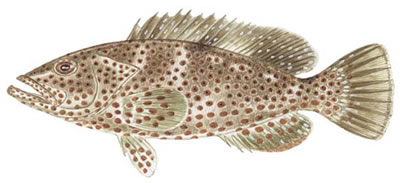A grouper in the Serranidae family, the rock hind is found in the same range as the red hind and is also good table fare. Divers can often distinguish the two species by their behavior alone, as the rock hind is reclusive and shies away from humans.
Identification
The rock hind has an overall tan to olive-brown cast, with many large, reddish to dark dots covering the entire body and the fins. Similar in appearance to the red hind, it has one to four distinctive pale or dark splotches along its back, appearing below the middle of the dorsal fin, behind the dorsal fin on the caudal peduncle, and below the spinous and the soft parts of the dorsal fin. The tail and the anal fins have broad, whitish outer edges but lack the additional blackish margins found on the dorsal, the caudal, and the anal fins of the red hind. The rock hind can pale or darken dramatically.Size
The rock hind can reach 2 feet in length; the all-tackle world-record fish is a 9-pounder. |
 |
